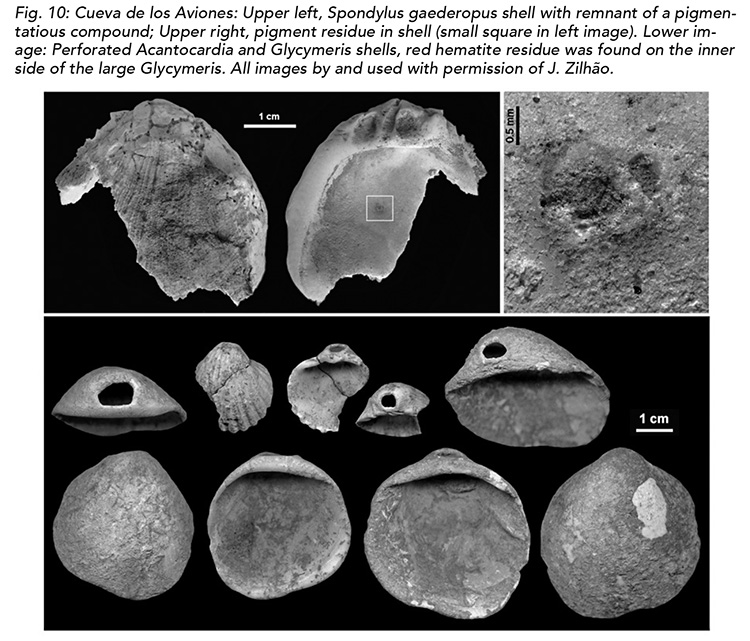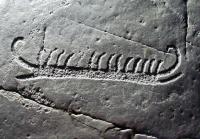Articles: Adoranten 2024
 In the early 20th century, the Font-de-Gaume cave contributed to the official and definitive recognition of Paleolithic cave art. Its renown stems from the quality of its engraved, drawn and painted works, sometimes in polychrome, as well as the majesty and parietal integration of its bison, mammoths, horses, reindeer, deer, ibex, aurochs, rhinoceroses, indeterminate animals and more, arranged in long processions on the walls of the main gallery, after the Rubicon, and of the terminal diverticulum, amassed on the voussoirs of the bison cabinet, or scattered at the crossroads and in the first few metres of the side gallery. But have these images, made world-famous by the masterly monograph and large picture book by Louis Capitan, Henri Breuil and Denis Peyrony published in 1910, been hiding a forest of parietal symbols for over a century, the immensity and richness of which are still unsuspected? To answer this question, an interdisciplinary research program led by the author of these lines was launched in 2020. Little by little, it is revealing the unique and original personality of an ultimately unknown cave.
In the early 20th century, the Font-de-Gaume cave contributed to the official and definitive recognition of Paleolithic cave art. Its renown stems from the quality of its engraved, drawn and painted works, sometimes in polychrome, as well as the majesty and parietal integration of its bison, mammoths, horses, reindeer, deer, ibex, aurochs, rhinoceroses, indeterminate animals and more, arranged in long processions on the walls of the main gallery, after the Rubicon, and of the terminal diverticulum, amassed on the voussoirs of the bison cabinet, or scattered at the crossroads and in the first few metres of the side gallery. But have these images, made world-famous by the masterly monograph and large picture book by Louis Capitan, Henri Breuil and Denis Peyrony published in 1910, been hiding a forest of parietal symbols for over a century, the immensity and richness of which are still unsuspected? To answer this question, an interdisciplinary research program led by the author of these lines was launched in 2020. Little by little, it is revealing the unique and original personality of an ultimately unknown cave.
The chamois belongs to the family Bovidae and to the species chamois (Rupicapra). The chamois was rarely figured by the artists of the European Upper Palaeolithic. The figures of chamois can be distinguished from those of ibex especially by the form of their horns and by the colour difference of the head which is sometimes indicated by a dark stripe the so-called the jugal band. All known figures are from sites located in France and the Iberian Peninsula.
In this article six representations of chamois from Upper Palaeolithic cave and portable art are analysed from an ethological point of view.
Key words: Chamois/Izard, Upper Palaeolithic, Portable art, Cave art, Ethology

This paper examines the discovery and mapping of newly identified painted imagery in Church Hole, located within the Creswell Crags, a natural gorge with caves that contain evidence of Late Upper Palaeolithic activity, in Nottinghamshire (within the northern Midlands of England). The recent findings, made in 2021 and 2024, build upon an earlier discovery by an Anglo-Spanish research team in 2003, which marked the identification of the first verifiable engraved Upper Palaeolithic rock art in the British Isles. This earlier discovery included engraved figurative representations and simple geometric motifs. Notably, several of the panels featured a calcite flow, which were chronometrically dated to the Late Upper Palaeolithic (approximately 13,000 years before present) using Uranium-Thorium dating techniques.
Currently, these newly discovered painted images, similar to the majority of the engraved images discovered in 2003 cannot be directly dated using chronometric dating techniques, owing to the absence of calcite flowstone over applied painted areas.

This paper examines the megalithic art found within the Middle Bronze Age Zurtaketi Kurgans of the South Caucasus. The kurgans, dating to the Trialeti culture (ca. 2000-1700 BCE), showcase a variety of engraved motifs, including geometric patterns, zoomorphic figures, and depictions of dwellings. Similar carvings found across the South Caucasus likely held symbolic or ritual significance and reflect broader megalithic tradition throughout the region. The analysis of these designs offers insights into the cultural and religious beliefs of the Trialeti communities during the Bronze Age.

Palaeolithic art and Neanderthals? Unless you have read recent research suggesting Neanderthals are responsible for the earliest parietal art in Europe this is not necessarily an association you conquer up. Western ideology has guided how we understand and interpret the past. This has led to an effect on our understanding of Palaeolithic art and the cognitive ability of Neanderthals. This article focuses on the cave paintings in Iberia that have recently been dated to before 40,000 years ago using Uranium Thorium(U-Th) dating method that extends the timeframe detected by C-14. Research results suggest Neanderthals may have created the first cave art in western Europe. It is no surprise that a debate ensues on the accuracy of the dating method and its results, while at the same time reprising the question of Neanderthals cognitive ability to create ‘art’.
 Who were the Neanderthals and what forms of symbolic material culture did they engage in? Part II provides a further historical background and overview of research over the past two decades on Neanderthals symbolic material culture to support the discussion in Part I (Adoranten 2024) on whether they had cognitive ability. No one disagrees that Neanderthals are not us- they are not the same as Homo sapiens. The question of cognitive ability centers on how Neanderthals are fundamentally different. Within that lies a cognitive process involved in knowing the needs, sources, or planning for tool making, mortuary practices, fishing-hunting-gathering for food, personal adornment, or making images on cave walls. It is important not to define humanity as one homogenous group or to confine the definition of mind as something encased in the brain: Both limit our understanding of ‘other’ cultures. Research points to a Middle Palaeolithic transformation that led to an increase of symbolic material culture in the Upper Palaeolithic- not the beginning of it, suggesting Neanderthals were clever enough to create markings on cave walls.
Who were the Neanderthals and what forms of symbolic material culture did they engage in? Part II provides a further historical background and overview of research over the past two decades on Neanderthals symbolic material culture to support the discussion in Part I (Adoranten 2024) on whether they had cognitive ability. No one disagrees that Neanderthals are not us- they are not the same as Homo sapiens. The question of cognitive ability centers on how Neanderthals are fundamentally different. Within that lies a cognitive process involved in knowing the needs, sources, or planning for tool making, mortuary practices, fishing-hunting-gathering for food, personal adornment, or making images on cave walls. It is important not to define humanity as one homogenous group or to confine the definition of mind as something encased in the brain: Both limit our understanding of ‘other’ cultures. Research points to a Middle Palaeolithic transformation that led to an increase of symbolic material culture in the Upper Palaeolithic- not the beginning of it, suggesting Neanderthals were clever enough to create markings on cave walls.

Like neighbouring southern Kazakhstan, mountainous Kyrgyzstan is rich in petroglyph sites from the Bronze Age to the Turkic Age. The largest and most important site is Saimaluu Tash, a remote place in the eastern Fergana Mountain Range where the petroglyphs are exceptionally well preserved. Most striking are the images of ploughs and light chariots, since the activities associated with such tools and vehicles cannot take place at such high altitudes, but only in valleys and plains. The meaning of such images may be found in ancient mythology.

A distinct ancient monument type, though of uncertain date, in the Baltic Sea Island of Bornholm, is described and discussed. On a number of granite rocks deliberately polished courses lead down a slope at a steep angle. The length of these shiny, polished surfaces varies from about 2 m to 10,4 m. The widths do not vary much, with an average at about 35 cm. Seven Bornholm surviving examples of these sliding tracks are presented, recorded in 2023, 2024, and Hammeren in 2025. In two cases, Klintebakken and Slamrebjerg, a sliding track is still in regular use. In other cases, information has been obtained regarding their use during the last 150 years. Seeking explanations for this distinct phenomenon, folklore evidence may connect the past with the present, suggesting fertility magic. However, a customary use just for fun, children’s games, is well recorded.

The Bronze Age lurs have been a central part of research in relation to the use of sound producing instruments and m usic in the Nordic Bronze Age, this also includes their occurrence at rock art sites. Over the years the focus on the Bronze Age lurs has caused a tendency to overlook other potential sound producing instruments. Therefore, the main goal for this research is to raise awareness of other instruments and musical behaviors. Are there other sound producing instruments depicted on rock art that have not been recognized? Potential bow instruments from Sweden will be presented and discussed. It is argued that there might be other sound producing instruments depicted on rock art, which have not yet been recognized. This might include bow instruments and other instruments. Musical behaviors can provide different aspects and views on the Bronze Age, and should therefore be seen as a highly important field of research.
Keywords: music, sound producing instruments, bow instruments, musical behaviors, drums, Sweden

|


